Raoul de Keyser, who has been accorded the honour of a one-man exhibition at the Whitechapel Gallery, seems an unlikely candidate for elevation to the status of Significant Twenty-First Century Artist. A seventysomething Flemish painter from Deinze, near Ghent, his works are erratically various in subject and appearance. They are characterised by a whimsical blend of pastiche abstraction and direct reference to the ordinary things encountered in a small town in Belgium. Modest objects, dry to the point of parsimony in their facture (it might have been supposed that a Belgian would have been more open to the potential affinity of oil paint with mayonnaise) they are often composed from just a few simple forms. Their colours tend to grubby impurity, occasionally shading into outright murk. Draughtsmanship, perhaps wisely, is kept to a bare minimum, restricted to the odd fuzzed outline or impulsive patch of painterly scribble.
De Keyser was largely self-taught, having spent much of his early working career as an arts journalist and sports commentator. Reminiscences of those former occupations may be discerned both in his habits of reference to art history and in his subject matter. For example Ground, a self-consciously banal painting which was apparently in gestation for 24 years, between 1971 and 1995, resembles a diagram of a section of a football pitch, a bird’s-eye view running from the edge of one penalty area to the half-way line. Its title is presumably a pun, also alluding to those formalist debates about the nature of painting, and the relationship between figure and ground, which raged during the 1960s, the decade when de Keyser decided to become an artist.
To borrow a sporting metaphor, de Keyser’s recent success goes very much against the run of play. He is old, his work lacks shock value, and it...

Raoul de Keyser and The Edge of the Real at the Whitechapel Gallery
08-02-2004

